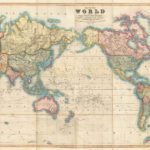Isolines
In Geography, it is often necessary to describe distributions on a map. Let’s consider an example that most of us are familiar with. Have you ever watched the weather report on your local nightly news? One of the important jobs of a meteorologist, or weatherman / weatherwoman, is to show their viewers the distribution of temperatures.
Meteorologists use isolines to quickly show these temperature differences on a map. The hottest areas are often colored red, the warm areas yellow, and the cold areas blue. Isolines are effective because they very quickly communicate the distributions being examined.

In addition to weather, isolines can also be used to describe any other type of data. For example, this population map uses isolines to represent the distribution of human beings around the Earth. Another common use of isolines is to show areas that are of the same elevation.

Some isolines have specific names. An isoline representing temperature is referred to as an isotherm. A contour line is an isoline that portrays elevation. Isolines that depict rainfall are called isohyets.






